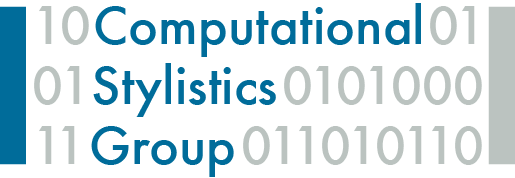Computational stylistics
A handful of projects conducted with the Computational Stylistics Group, or a cross-institutional research team focused on computer-assisted text analysis, stylometry, authorship attribution, sentiment analysis, and the like stuff.

The research projects conducted by the Computational Stylistics Group members can be described broadly as computer-assisted text analysis, or text-centric Digital Humanities. They include the package ‘stylo’, the Rolling Stylometry method, and Bootstrap Consensus Networks which were briefly covered elsewhere on this website, but also a few other research projects that I’ve been involved in. Below, I give a super-compact list of them – please follow the links to see more comprehensive descriptions:
-
Foundations of Computational Stylistics, a 5-year project founded by the National Science Centre (SONATA-BIS 2017/26/E/HS2/01019), carried out at the Institute of Polish Language (Polish Academy of Sciences). It is aimed to develop, evaluate and apply an innovative methodology of comparing large texts collections, in order to identify hidden patterns and similarities invisible to the naked eye.
-
A series of papers on stylometric methodology, including a study on minimal sample size (Eder 2015a) and its follow-up (Eder 2017b), on the strength of the authorial signal in correlation with different vectors of frequent words (Rybicki and Eder 2011), on appropriate choice of texts for the training set in machine-learning classification techniques (Eder and Rybicki 2013), on systematic errors in authorship attribution (Eder 2013), and so forth.
-
A study on the authorship of The Polish Chronicle traditionally ascribed to Gallus Anonymous, in which I corroborate the “Venetian” hypothesis formulated by Tomasz Jasiński: stylometric evidence seems to confirm that the author of the Chronicle and the Monk of Lido is one and the same person (Eder 2015b, 2017a).
-
Grammatical and lexical changes in the history of the Polish language, a 3-year project, founded by the National Science Centre (OPUS 2013/11/B/HS2/02795), is aimed at an investigation of grammatical and lexical changes, focusing on trends and dynamics of changes in the middle and modern Polish period. One of the deliverables is the monograph Zmiana w języku. Studia kwantytatywno-korpusowe (more on this study: here).
-
A study on Elena Ferrante as a virtual author, in which the aim was to corroborate recent rumours that the actual person under the acclaimed pseudonym is in fact Domenico Starnone, a Neapolitan writer (Eder 2018). However, I wanted to ask a slightly different question, namely whether a (skilled) writer can develop two distinct authorial voices: What if there are in fact two personae in one writer, the actual Starnone and a virtual “Ferrante”?
-
Harper Lee and other people is a study on stylometric evidence in two novels by Lee: the Pulitzer Prize winning To Kill a Mockingbird (1961) and Go Set A Watchman (2015), sometimes claimed to be written (or at least heavily edited) by Truman Capote. What we find is no evidence of Capote but some obscure stylistic idiosyncrasies in the climactic chapter of the Mockingbird (Choiński et al. 2019).
References
Choiński, M., Eder, M. and Rybicki, J. (2019). Harper Lee and other people: a stylometric diagnosis. Mississippi Quarterly, 70/71(3): 355–374.
Eder, M. (2013). Mind your corpus: systematic errors in authorship attribution. Literary and Linguistic Computing, 28(4): 603–614, [pre-print].
Eder, M. (2015a). Does size matter? Authorship attribution, small samples, big problem. Digital Scholarship in the Humanities, 30(2): 167–182, [pre-print].
Eder, M. (2015b). In search of the author of “Chronica Polonorum” ascribed to Gallus Anonymous: A stylometric reconnaissance. Acta Poloniae Historica, 112: 5–23, [pre-print].
Eder, M. (2017a). Autorstwo „Kroniki” Anonima zwanego Gallem w świetle badań stylometrycznych: rekonesans. In Dąbrówka, A., Skibiński, E. and Wojtowicz, W. (eds), Nobis operique favete. Studia nad Gallem Anonimem. Warszawa: IBL PAN, pp. 59–74.
Eder, M. (2017b). Short samples in authorship attribution: A new approach. Digital Humanities 2017: Conference Abstracts. Montreal: McGill University, pp. 221–224, https://dh2017.adho.org/abstracts/341/341.pdf.
Eder, M. (2018). Elena Ferrante: a virtual author. In Tuzzi, A. and Cortelazzo, M. A. (eds), Drawing Elena Ferrante’s Profile. Padova: Padova University Press, pp. 31–45, http://www.padovauniversitypress.it/publications/9788869381300.
Eder, M. and Rybicki, J. (2013). Do birds of a feather really flock together, or how to choose training samples for authorship attribution. Literary and Linguistic Computing, 28(2): 229–236, [pre-print].
Rybicki, J. and Eder, M. (2011). Deeper Delta across genres and languages: do we really need the most frequent words? Literary and Linguistic Computing, 26(3): 315–321, [pre-print].